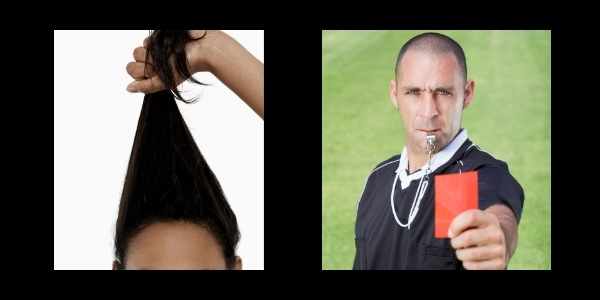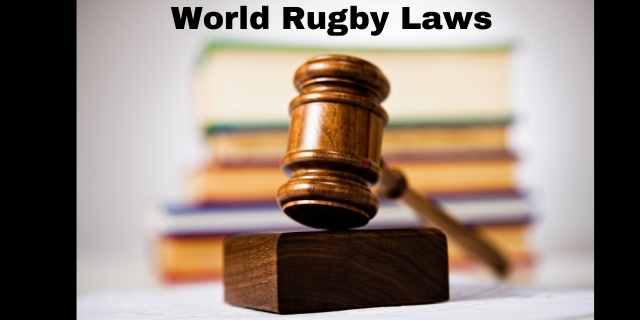You’ll occasionally see rugby players making a tackle by pulling their opponent’s hair.
Tackling by the hair is illegal in rugby, although there’s no specific law in the rule books that mention hair-pulling.
This article looks at how referees deal with incidences, and we’ll show you some high-profile examples (and the mass brawls that ensued).
Is It Legal In Rugby To Tackle A Player By The Hair?

Tackling a player by pulling their hair is illegal in rugby. If the referee deems the incident to be accidental, then a penalty kick will be awarded.
If the tackler’s actions are deemed to be reckless or intentional, the referee can award a yellow or red card. Match bans have also been issued.
Can hair-pulling be accidental?
You may be wondering how hair-pulling can be accidental. However, some players have long hair or dreadlocks that fall down their backs.
You’ll often see would-be tacklers desperately flailing and grasping for a player’s jersey. Sometimes they can get a handful of hair instead. It’s usually obvious when it’s an accident.
If the referee only gives a penalty kick, the player can be cited after the game by the match commissioner.
This has happened before when former England winger Chris Ashton was handed a four-match ban. I’ll cover that in the later section on famous incidents.
What do the laws say?

There’s no explicit mention of hair-pulling in the laws. However, the rules that protect players’ heads are applied here.
The relevant rugby law is the section on Foul Play which reads as this:
Dangerous tackling includes, but is not limited to, tackling or attempting to tackle an opponent above the line of the shoulders.
World Rugby Laws number 9
There’s no point in arguing that dreadlocks or long hair fall below the shoulders. The effect is to snap the player’s head backward, and it’s potentially very dangerous.
Referees can also point to another more general law, which has been used at least once to hand out a four-match ban.
A player must not do anything that is against the spirit of good sportsmanship.
World Rugby Laws number 27
Why Is Hair Pulling Rare In Rugby?
There are other infringements in rugby that are far more common e.g. tackling in the air, or dump tackles.
You’re less likely to see hair pulling, as it is very disliked by other players and by supporters. The victim’s teammates react to it in the same way as they react to eye-gouging or foot trips.
Part of this is because it’s completely against the kind of macho stereotype that rugby brings with it.
Players on both sides will forgive a late tackle (or have a sly grin about it). But everybody takes a dim view on pulling hair. I’ve seen mass brawls break out on the pitch after an obvious hair-pulling incident.
Because of this, referees are even more likely to be harsh about it. They don’t want the opposition players to be provoked into looking for payback.
Famous Incidents Of Hair Pulling In Rugby
Here are some well-known incidents of hair pulling in high-profile matches.
Ireland vs Australia, 2003 Rugby World Cup
Legendary Australian flanker George Smith was known in his younger years for sporting dreadlocks.
I think the earliest incident of hair-pulling I’ve seen on the pitch was when Ireland legend Brian O’Discoll got a handful of dreadlocks when he went high in a tackle. The referee awarded a penalty kick.
Here’s the footage on YouTube.
I think there’s no doubt that was accidental, and the commentators were a little surprised.
“Well, that’s a new one. There are 400 laws and regulations in the rugby rule book but I don’t know whether pulling by the hair is there.
I’ve already addressed how the laws are interpreted to rule this as an infringement.
Wingers’s Four Match Ban
By 2011, the World Rugby authorities were trying to get rid of brawls and fights from games.
Northampton Saints were playing a derby match against Leicester in the English Premiership.
England winger Chris Ashton tackled his opposite number, Alesana Tuilagi, from behind. Tuilagi sported dreadlocks, and Ashton used them to drag his opponent off the pitch!
A mass brawl ensued with plenty of blows traded. Two players were given red cards, but Ashton escaped unpunished.
Here’s the footage on YouTube.
After the match, Ashton was cited for bad sportsmanship. The disciplinary committee pointed out that his actions had incited the brawl. They gave him a four-match ban.
This is what the disciplinary panel had to say:
If you pull somebody by the hair there is an element of denigration and this act was a catalyst for a mass brawl that resulted in two red cards and significantly affected the image of the game.
Quoted in the Guardian
Australia vs South Africa, 2017
Years later, Israel Folau pulled back a South African player by the hair. In this case, Dillyn Leyds didn’t have dreadlocks. Instead, he was sporting a fashionable man-bun.
Here’s the footage on YouTube.
Again, I think that Folau was going for the collar – which is also an infringement. But he got a handful of man-bun instead.
The player’s incensed teammates rush in for retribution and a bit of a brawl ensues.
Eventually, the referee deemed it as a high tackle and awarded a penalty kick. It’s a bit surprising that he didn’t award a card.
With the more recent emphasis on protecting players’ heads, I think the same incident would get a yellow card now.
Canada vs Brazil, Tokyo Olympics

This was a sevens match in the 2020 Tokyo Olympics between the Canadian and Brazilian womens’ teams.
An unfortunate Canadian player is yanked back by her ponytail. Here’s some footage of the incident.
“It’s a hair pull,” says the referee clearly. “It’s a yellow card offense”.
Should Rugby Players Have Long Hair?
There’s an argument to be made that rugby players with long hair should bunch it up under a scrum cap when they take to the field. This would be for their own safety.
However, hair pulling is very infrequent in the sport. Now that it’s more likely to be a yellow card and not just a penalty kick, it seems to be even rarer.
So, there doesn’t seem any need to legislate against long hair.